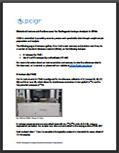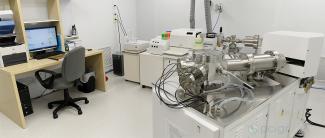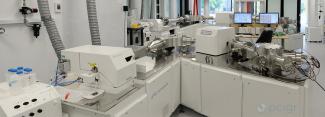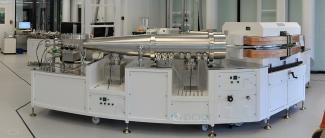PCIGR’s multicollector ICP-MS instruments are configured to measure radiogenic isotopic ratios (Nd, Hf, Pb) and stable isotope ratios of elements ranging from Li to U, all at high-precision and on a wide variety of sample types.
|
Make/model |
Services |
|
High-resolution isotopic analyses |
* Can be coupled to a split-stream laser ablation system
PCIGR actively monitors the performance of these instruments through the analysis of standards (e.g., SRM 981, JMC-475, La Jolla or JNdi) and reference materials (USGS and others). To see a gallery of our historical instrument performance, click on the thumbnail image below.

PCIGR-radio-iso-analysis-SRM [PDF]
Nu Instruments Nu Plasma

Nu Instruments Nu Plasma multicollector ICP-MS at PCIGR. Photo: D. Weis.
While the Nu Plasma is capable of ionizing most elements, we use the Nu Plasma to analyze radiogenic (Nd, Hf, Pb) and non-traditional stable isotopes (Li, Fe, Cu, Zn, Mo, Cd).
Installed at PCIGR in 2002, the Nu Plasma (serial number 021) is equipped with the following features:
- DSN-100 desolvating nebulizer (with matching cones for operation in dry plasma conditions)
- 80-L primary pump for improved pumping at the interface
- Electrostatic analyzer, 25-cm radius magnet, two zoom lens stacks to focus the ion beam
- Adjustable entrance slit for increased isobaric resolution and measurement of Fe isotope ratios under pseudo-high-resolution conditions
- Fixed array of 12 Faraday cups and 3 ion-counting multipliers
The Nu Plasma is used to analyze the following types of samples in solution:
- Rocks
- Minerals
- Metal ores from smelting and refining processes
- Organic matter
The Nu Plasma can also be connected to an Elemental Science Lasers/New Wave Research NWR193UC laser ablation system for the following in-situ analyses:
- U-Pb geochronology of detrital and igneous zircons
- Hf isotope ratios in garnet
For simultaneous measurement of Hf isotope ratios and U-Pb geochronology on the same sample run, we use split-stream laser ablation ICP-MS. This technique connects both the Nu Plasma and a Thermo Scientific Element 2 ICP-MS to the NWR193UC laser ablation system.
For details on instrumentation and submitting samples, contact:
- Dr. Dominique Weis and Dave Daquioag for radiogenic isotopes
- Dr. Dominique Weis and Dr. Marg Amini for non-traditional stable isotopes
Consult the Fees page for analytical costs.
Nu Instruments Plasma II

Nu Instruments Plasma II double-focusing magnetic sector ICP-MS in the nUBC facility at PCIGR. Photo: D. Weis.
The Plasma II is a double-focusing magnetic sector multicollector ICP-MS that evolved from the Nu Plasma and Plasma HR designs.
Installed at PCIGR in 2012, and upgraded with a high-sensitivity interface (Plasma 3) in 2019, the Plasma II (serial number 214) is equipped with the following features:
- Direct solution aspiration system, and DSN-100 (dry plasma) or Cetac Aridus II (wet plasma) desolvating nebulizer for increased sensitivity and reduced oxide formation
- High-sensitivity cones that increase overall sensitivity without compromising accuracy and precision
- 16 Faraday detectors and 5 full-size ion-counting multipliers for the study of multiple isotope systems
- Upgraded zoom optics for faster response time
Although mainly used for radiogenic isotopic measurements (Pb, Hf, Nd) in unit mass resolution, the Plasma II at PCIGR is also capable of pseudo-high-resolution measurements when mass interferences are on the same side of the peak.
Ideal results (i.e., without loss of reproducibility) can be achieved with analyte quantities as low as 10, 20 and 25 ng for Pb, Hf and Nd, respectively, for isotopic measurement.
Contact Dr. Dominique Weis and Dave Daquioag for details on instrumentation and submitting samples.
Consult the Fees page for analytical costs.
Nu Instruments Plasma 1700

Nu Instruments Plasma 1700 high-resolution multicollector ICP-MS in the nUBC facility at PCIGR. Photo: D. Weis.
The Plasma 1700 is a double-focusing multicollector ICP-MS with a design that encompasses large geometry/mass dispersion and a unique collector slit.
Installed at PCIGR in 2013, the Plasma 1700 is equipped with the following features:
- DSN-100 (dry plasma) or Cetac Aridus II (wet plasma) desolvating nebulizer
- Cetac ASX-100 autosampler for long runs with minimized downtime
- Continuously adjusted source slit and alpha/beta slits before an electric sector analyzer for high resolution, precision and accuracy and minimal loss of sensitivity
- Slits adjustable in width and central position before each collector for independent variable resolution on each collector
- Fixed core of 10 Faraday detectors and 6 movable detectors with 3 on each mass side
- 3 ion-counting multipliers interspersed on the low-mass side
- High abundance deceleration filters available for each ion counting detector
- Enhanced variable zoom optics for maximum flexibility
The Plasma 1700 is used for the following isotope analyses:
- Routine radiogenic isotope analyses (Pb, Hf and Nd) at very high precision and accuracy
- Challenging Fe and Si analyses, with stable and reliable results, e.g., δ56Fe precision of 0.04‰ (2σ) in igneous rocks
For details on instrumentation and submitting samples, contact:
- Dr. Dominique Weis and Dave Daquioag for radiogenic isotopes
- Dr. Dominique Weis and Dr. Marg Amini for non-traditional stable isotopes
Consult the Fees page for analytical costs.